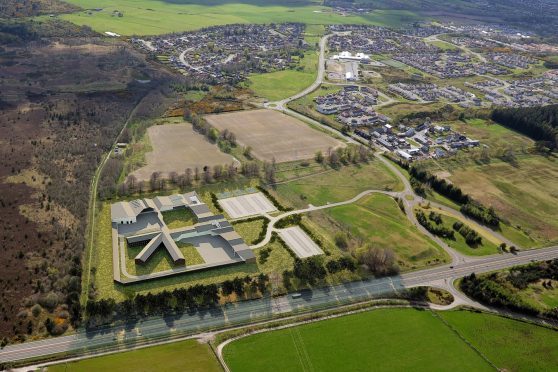This is a bird’s eye view of how the controversial new Inverness jail would fit into the landscape on the outskirts of the Highland capital.
Prison chiefs insist the complex at Milton of Leys on the southern edge of the city would be well hidden and far less prominent than critics fear.
But the instant reaction from residents yesterday suggested they still have a battle on their hands to convince people they have chosen the right site.
There has already been significant public opposition to the Scottish Prison’s Service’s preferred location for a replacement for ageing and overcrowded Porterfield jail in the Crown area of the city.
Objectors fear a blot on the landscape at the city gateway on the west side of the A9 – and a potential risk to public safety because it is close to homes and a primary school.
Some residents also claim the SPS, which has lodged a pre-planning application with Highland Council, has failed to consult locals on the project, although two public events have been arranged.
Today, the Press and Journal offers an exclusive first look at drawings of how the prison would look, if approved by councillors in its current form.
But local members Ken Gowans was unimpressed with the designs.
He said: “It’s worse than I’d anticipated, given the scale of it. It doesn’t give me any comfort.
“It’s a sizeable complex and it’s right on the A9, so you would certainly see it.
“You don’t know how much of it you’d see above the perimeter wall. And you’d still have to add, presumably, some sort of razor wire around the complex for security.”
The SPS maintains the proposed facility would allow the provision of a “fit for purpose regime for those in custody” to enhance their chances of rehabilitation.
It is believed that the building would be no more than two storeys high.
The SPS is confident that, with sensitive landscaping, “you could probably drive past it and you wouldn’t know it was there”.
Responding to security concerns, it pointed out that several other Scottish prisons were located in the heart of communities without any danger to the population.
A spokesman for the service said: “It’s our intention to build a new prison which can provide suitable accommodation for the people of the Highlands and islands, keeping them closer to their families and communities.
“Whilst the capacity for the existing prison is 103, the average (Inverness) prison population since 2010 has been 130 with a peak of 160. It will still be one of Scotland’s smallest prisons.
“To ensure the site has the necessary resilience and the relevant utilities have adequate capacities certain initial studies have been based on a maximum design capacity of 200 places.”
The new complex would predominantly accommodate adult male, untried and convicted prisoners.
Most of the convicted prisoners would be serving sentences of up to four years.
The SPS has been searching for a site for “HMP Highland” since 2008.
Councillors opposed to its preferred site have argued it would breach the local plan because the area is zoned for “business use” – and that a prison is not a business.
Steve Gordon, of protest group Highlands Against the Proposed Prison Location, described the artist’s impression of the complex as “an attempt at a soft launch ahead of the public consultation”.
He said: “This is the wrong location for a prison so it doesn’t matter what the design is – and that looks very utilitarian and doesn’t really fit with the Scottish Government’s own masterplan for Milton of Leys and the Balvonie development.”
The SPS rejected a dozen other sites for the prison, facilities building and community integration unit.
Milton of Leys objectors have vowed to take their fight all the way to a public inquiry if necessary.
Public exhibitions are planned for 2pm-7pm at Inshes Church on May 26 and June 8.
